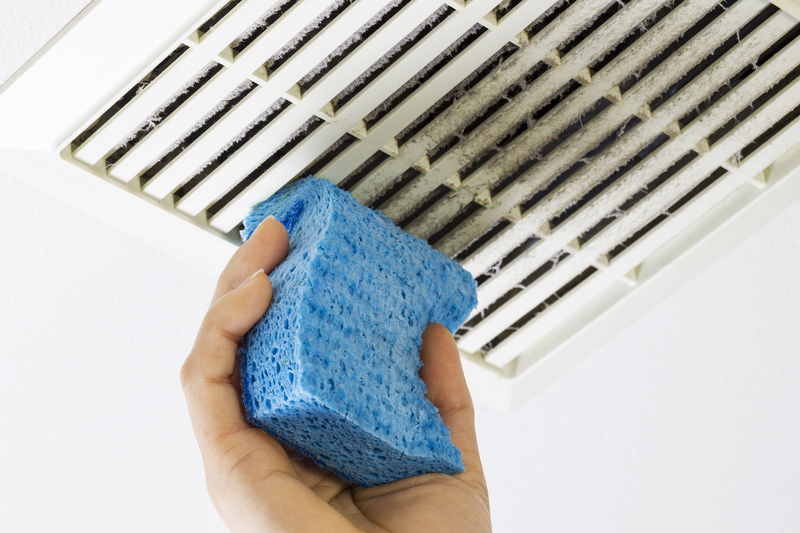The Invisible Force: Air Quality's Impact on Health at Home and Work
Posted on 08/09/2025
The Invisible Force: Air Quality's Impact on Health at Home and Work
Introduction: Why Air Quality Matters
Every day, we breathe in approximately 20,000 liters of air. Much of this air is inhaled within indoor spaces, where air quality can have a profound but often overlooked impact on our well-being. Whether at home or in the workplace, the air we breathe wields an invisible yet powerful force over our health, productivity, and quality of life. Understanding the specific risks and solutions associated with indoor air pollution is essential, especially as modern lifestyles keep us indoors for up to 90% of our time.

What Is Air Quality? Breaking Down the Basics
Air quality refers to the purity or cleanliness of the air we breathe, measured by the presence of pollutants, allergens, and toxic particles. Good air quality means minimal hazardous contaminants, whereas poor indoor air quality signals the presence of substances that jeopardize our health.
- Indoor Air Quality (IAQ): The air quality within and around buildings and structures, especially related to the health and comfort of building occupants.
- Outdoor Air Quality: Usually discussed in terms of smog, car emissions, and industrial pollution, but these outdoor factors often seep into homes and offices, affecting IAQ.
The World Health Organization (WHO) and various environmental agencies have highlighted the critical importance of air quality as a public health concern, propelling the issue into conversations about health at home and work.
Common Indoor Air Pollutants: Unseen and Ubiquitous
Many harmful substances are invisible yet omnipresent in the air around us. Understanding these pollutants helps to pinpoint sources and mitigation strategies.
Biological Pollutants
- Mold and Fungi: Thrive in damp, poorly ventilated environments. They release spores that can trigger respiratory problems.
- Dust Mites: Their waste products are leading allergens in indoor air.
- Pollen and Pet Dander: Small, lightweight particles that circulate indoors and provoke allergies.
- Bacteria and Viruses: Spread especially in crowded or inadequately ventilated spaces, leading to more frequent illness outbreaks.
Chemical Pollutants
- Volatile Organic Compounds (VOCs): Found in paints, cleaning products, and furnishings. These chemicals evaporate into the air and can linger for years.
- Formaldehyde: Used in building materials and certain textiles. It is a known carcinogen.
- Pesticides and Cleaning Agents: Everyday household products can release hazardous fumes affecting lung health.
- Tobacco Smoke: Secondhand smoke is a major contributor to poor indoor air quality, even after the smoking has stopped.
Physical Pollutants
- Particulate Matter (PM2.5 and PM10): Microscopic particles from combustion appliances, candles, and outdoor pollution that can penetrate deep into the lungs.
- Asbestos Fibers: Once widely used in construction, asbestos can become airborne during renovations or deterioration.
- Lead Dust: Present in homes built before the 1970s due to old paint and pipes.
The Health Impacts of Indoor Air Quality: Silent but Serious
The consequences of poor air quality extend from mild irritations to severe, chronic illnesses. The symptoms may be subtle at first, making the problem hard to identify without thorough air testing.
Short-Term Effects
- Irritated eyes, nose, and throat
- Frequent headaches and dizziness
- Allergic reactions and asthma attacks
- Fatigue and reduced cognitive function
These acute symptoms are often mistaken for seasonal allergies, stress, or viral infections but may be direct results of poor air quality at home or at work.
Long-Term Impacts
- Respiratory diseases: Chronic exposure can lead to asthma, COPD, and other long-term breathing problems.
- Cardiovascular issues: Pollutants like fine particulates and VOCs can trigger heart disease and increase the risk of strokes.
- Cancers: Long-term exposure to substances like radon, asbestos, and formaldehyde increases cancer risk.
- Mental Health: Emerging research suggests a link between poor indoor air quality and mental health challenges such as anxiety and cognitive decline.
- Immunity Suppression: Persistent inhalation of pollutants weakens the immune system, making individuals more susceptible to infections.
Vulnerable Populations
Children, the elderly, pregnant women, and those with pre-existing health conditions are especially sensitive to the damaging effects of poor indoor air quality. For these groups, cleaner air is not a luxury--it is crucial for sustaining health and well-being.
Air Quality at Home: Where Comfort Meets Hazard
Home is considered a safe haven, yet hidden pollutants often challenge that assumption. Families perform many activities--cooking, cleaning, relaxing--each potentially releasing or circulating contaminants.
Major Sources of Indoor Air Pollution at Home
- Cooking: Especially with gas stoves, which emit nitrogen dioxide, carbon monoxide, and particulates.
- Heating: Wood-burning stoves and fireplaces release smoke and soot; even central heating can create dry, dusty air.
- Cleaning Products: Many household cleaners emit VOCs that linger in the air.
- Renovations and Furnishings: New carpets, paints, and pressed-wood furniture commonly off-gas harmful chemicals.
- Poor Ventilation: Insufficient airflow allows pollutants to accumulate indoors instead of being expelled.
Many modern energy-efficient homes are tightly sealed, trapping pollutants inside while reducing natural ventilation.
Workplace Air Quality: Productivity and Safety at Stake
We spend a significant part of our lives at work, making workplace air quality a substantial factor in both health and job performance. According to the U.S. Environmental Protection Agency (EPA), poor indoor air is one of the top five environmental risks to public health.
Common Office Air Quality Issues
- Poor Ventilation: Many office buildings recycle air to save on HVAC costs, which can cause a build-up of contaminants.
- Building Materials: Carpets, adhesives, furniture, and printers emit chemicals and particulates into the air.
- Cleaning Chemicals: Frequent, heavy-duty cleaning may do more harm than good when strong chemicals are used.
- Crowded Spaces: Higher occupancy increases CO2 levels and the transmission of pathogens.
Health and Economic Impacts
Poor air quality at work leads to more sick days, lower productivity, and higher medical costs. Employees exposed to poor workplace air quality report:
- More frequent headaches and fatigue
- Increased asthma and allergy symptoms
- Decreased concentration and performance
- Higher absenteeism and staff turnover
*Studies confirm that improving air quality improves cognitive scores, decision-making, and workplace satisfaction.*
The Role of Ventilation and Airflow in Maintaining Air Quality
Proper ventilation is the most effective line of defense against indoor air pollution. Bringing fresh outdoor air inside dilutes accumulated pollutants and helps maintain a healthy environment.
Types of Ventilation
- Natural Ventilation: Utilizes open windows, vents, and doors to allow air exchange. Most effective in mild climates.
- Mechanical Ventilation: HVAC systems, exhaust fans, and air handlers actively move air in and out of buildings. Allows for consistent air quality control in large or sealed environments.
Regular maintenance of ventilation systems (filter changes, duct cleaning, professional inspections) ensures they function effectively and do not become sources of pollution themselves.
Improving Air Quality: Practical Steps for Homes and Workplaces
Enhancing indoor air quality does not always require dramatic renovations. Many improvements are straightforward and cost-effective.
Practical Tips for Homeowners
- Open windows regularly (if outdoor air quality is good) to promote airflow.
- Use exhaust fans in kitchens and bathrooms to remove moisture and fumes.
- Reduce clutter and dust regularly, using a vacuum with a HEPA filter.
- Limit use of candles, incense, and air fresheners that emit particulates and chemicals.
- Choose low-VOC paints and cleaning products.
- Monitor humidity (ideally 30-50%) to deter mold growth; use a dehumidifier if necessary.
- Add indoor plants, which can help filter some pollutants (but note they are not a catch-all solution).
- Consider an air purifier with a true HEPA filter for bedrooms, nurseries, or allergy-prone individuals.
- Test for radon and carbon monoxide and install detectors where needed.
- Avoid smoking indoors entirely.
Steps for Employers and Building Managers
- Assess ventilation regularly and improve air exchange rates as needed.
- Maintain HVAC systems, replacing filters on schedule with high-efficiency versions.
- Choose non-toxic cleaning schedules and time-intensive cleaning during off-hours.
- Monitor for common workplace pollutants, such as mold, VOCs, or asbestos.
- Allow personal control of workspace air, e.g., desk fans or window access.
- Conduct indoor air quality testing and share results transparently with employees.
- Promote "no-smoking" policies and educate staff on air quality's importance.
- Encourage green, sustainable materials for renovations or upgrades.
Smart Technology for Air Quality Monitoring
Innovative air quality monitors, many of which are now accessible and user-friendly, can track a variety of common pollutants. These devices provide real-time data and alerts that enable prompt action, helping individuals and employers keep indoor air quality at optimal levels.
- Smart sensors: Detect particulates, CO2, VOCs, humidity, and temperature.
- Mobile apps: Alert users to changes or dangers in home or business environments.
- Integration: Many systems now interface with smart thermostats, air purifiers, and building management systems for automated adjustments.

The Future of Air Quality: Trends and Challenges
As awareness of air quality's impact on health at home and work grows, regulations and design standards are evolving. "Green buildings," improved filtration technology, and sustainable materials are reshaping how we approach healthy living and working environments.
- COVID-19 Pandemic: Has vastly accelerated interest in air filtration and ventilation standards worldwide.
- Urbanization: Increases challenges due to nearby outdoor pollution sources seeping indoors.
- Climate Change: Alters pollen patterns and encourages the spread of mold and allergens.
- Remote and Hybrid Work: Draws attention to home office air quality as a productivity issue.
Maintaining excellent indoor air quality is not just a one-time fix--it's an ongoing commitment that pays dividends in health, comfort, and efficiency. As technology advances, so too do our options for monitoring and improving the air around us.
Conclusion: The Clear Choice for Well-Being
Beneath the surface of daily routines, air quality remains an invisible yet decisive force shaping our health and well-being at home and in the workplace. By understanding pollutants, recognizing symptoms, and prioritizing proactive solutions, we can create environments that support longevity and productivity. The path to better home and workplace air quality is clear: regular testing, sustained vigilance, and an unwavering commitment to clean, fresh air.
Investing in air quality is an investment in yourself, your family, and your colleagues. Breathe easier--and live better--by making indoor air quality a cornerstone of your healthy lifestyle.





